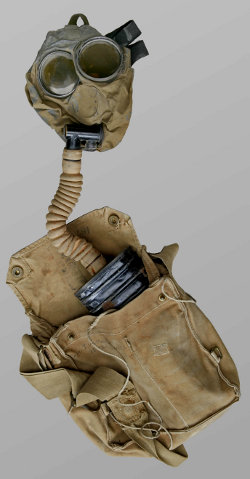Topic: CEF
Excerpted from "Trench Warfare; A Manual for Officers and Men," by J.S. Smith, Second Lieutenant with the British Expeditionary Force, E.P. Dutton & Co., 1917.

Image of a Small Box Respirator as shown on the Canadian War Museum website (CWM 19720102-061). (Page link.)
Gas Masks or Respirators
The Box Respirator at present in use on the Western Front is the latest improvement, and proof against any gas that so far has been used, but should such a thing happen that a man be caught without his box respirator, any of the following improvised methods are good:
1. Wet and ring out any woolen article, such as a stocking, muffler or cap comforter, so as to form a thick pad large enough to cover the nose and mouth, and press firmly over both.
2. Place in a scarf, stocking or handkerchief, a pad of about three handfuls of damp earth, and tie firmly over the nose and mouth.
3. A wet cap comforter will be found useful as additional protection, especially against certain gases other than chlorine.
4. A cap comforter wetted with water and soda solution or tea, folded into eight folds and firmly held over the nose.
5. A sock folded fourfold similarly wetted and held or tied. If the sock or comforter has been soaked in soda solution it will act efficiently when dry, though, if possible, it should be moist. The spare tapes from puttees may be used for tying on the sock or cap comforter.
6. Any loose fabric, such as a sock, sandbag, woolen scarf or comforter, soaked in urine, then wrung out sufficiently to allow of free breathing and tied tightly over the nose and mouth. In the absence of any other cloths, the flannel waistbands issued for winter use could be used for this purpose.
Every officer defending a trench against an enemy gas attack should endeavor to collect information whenever possible to be sent to headquarters regarding the capture of apparatus used by the enemy either for disseminating or protection from gas. If a gas shell attack is made, unexploded shells or portions of them should be sent ; the time of day, duration of attack, color, taste or smell of gas used, effect on the eyes, breathing, and all other symptoms should be noted. New gases may be used at any time, and speedy information greatly helps the adopting of protective measures.
The area of the gas attack is very large and will sometimes cover as far back as 12 to 15 miles behind the lines, although at that point it is not generally dangerous, but for three to four miles the gas has a killing power, and precaution should be taken anywhere within that length of the firing line the same as though in the firing line.
Another nuisance resulting from a gas attack is the wholesale slaughter of rats and other animals that infest the trenches, and while a very unpleasant job, steps should at once be taken to gather these beasts up and bury them in some place, obviously for sanitary reasons.
Joseph Shuter Smith
Joseph Shuter Smith was an American author born in Philadelphia in 1893. He spent his childhood in Alaska during the Gold Rush and spent his years before the Great War as a lumberjack, miner, surveyor and cowboy. In 1914, continuing his adventurous streak, he went to Canada and enlisted in the Canadian Expeditionary Force, declaring his birthplace to be Port Hope, Ontario (with next of kin in Oakland, California). Smith enlisted with the 29th Canadian Infantry Battalion at Vancouver. He served in France and Belgium as a soldier in the CEF and, after being commissioned in August, 1916, as an officer of the British Army with The Royal Scots (Lothian Regiment). He resigned his Imperial commission after a year to return to the US and enlist in the American Army. Joseph Smith also wrote the memoir: Over There and Back in Three Uniforms; Being the Experiences of an American Boy in the Canadian, British and American Armies at the Front and through No Man's Land.

